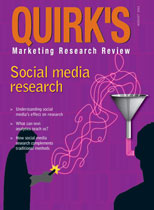Editor's note: This article appeared in the August 8, 2011, edition of Quirk's e-newsletter.
Three out of five drivers with cell phones use them while driving even though almost all adults (91 percent) know it is unsafe to do so, according to data from Rochester, N.Y., research company Harris Interactive. Use of a mobile device while driving is particularly common among younger drivers with cell phones.
In addition, 22 percent of drivers with cell phones send or read text messages while driving. However the percentage of drivers with cell phones who use them while driving has fallen over the last two years, from 72 percent in 2009 to 60 percent in 2011. The number of those who text while driving has fallen a little from 27 percent to 22 percent.
Several studies have shown that drivers who use cell phones while driving are much more likely to be involved with accidents and it is believed that texting is even more dangerous. Recent research has shown that both handheld and hands-free cell phones are almost equally dangerous because they are equally likely to distract drivers. However, more than three-quarters of the public believe that hands-free phones are safer.
The younger age groups, Echo Boomers (72 percent) and Gen Xers (69 percent) are more likely to use cell phones while driving than Baby Boomers (59 percent) and much more likely than drivers ages 65+ (32 percent) to do so.
The Lake Wobegon effect ("where all the children are above average") is alive and well. Most drivers (57 percent) rate themselves as better-than-average drivers. Only 1 percent rate themselves as worse than average. At 66 percent, men are much more likely than women (48 percent) to think that they are better-than-average drivers.
Texting while driving is also much more common among younger drivers. Nearly half of drivers under age 35 with cell phones send or read text messages while driving, compared to only 24 percent of Gen X; 11 percent of Baby Boomers; and less than 1 percent of people over age 65.
Most drivers (60 percent) who use cell phones while driving use handheld phones. This number has declined from 72 percent in 2006 and 66 percent in 2009. The large majority who know that it is dangerous to use a cell phone while driving has increased from 82 percent in 2006 to 91 percent in 2011 and the percentage of the public who live in states that require (or, which they believe, require) the use of hands-free phones has increased from 14 percent in 2006 to 38 percent in 2011.
